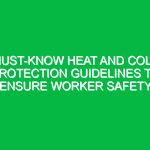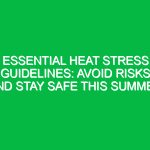“`html
Essential Heat-Related Illness Response Guidelines to Save Lives
Good morning team,
Today, we’re going to discuss a critical topic that affects us all during the warmer months: heat-related illnesses. As we work under the sun or in hot environments, understanding how to recognize and respond to heat-related illnesses can make the difference between life and death. Our focus is on the Essential Heat-Related Illness Response Guidelines to Save Lives, and I urge everyone to pay close attention.
Understanding Heat-Related Illnesses
Heat-related illnesses occur when the body cannot cool itself adequately, leading to various health issues. The primary types of heat-related illnesses include heat exhaustion, heat cramps, and the most severe form, heat stroke. Each of these has its symptoms and requires immediate attention.
It’s important to understand that heat can significantly impact our daily operations. When temperatures rise, so do the risks of these illnesses, affecting our productivity and overall well-being. A common misconception is that only those working outdoors are at risk; however, anyone exposed to high temperatures, even indoors, can experience heat-related illnesses.
Key Hazards, Risks, and Safety Considerations
Identifying specific Hazards is crucial for preventing heat-related illnesses. Here are some key risks:
- High Temperatures: Working in environments where temperatures exceed 80°F can increase risk.
- Humidity: High humidity levels make it difficult for sweat to evaporate, hindering the body’s cooling mechanism.
- Physical Exertion: Heavy physical work increases body temperature and sweat loss, making hydration essential.
- Inadequate Hydration: Failing to drink enough water can lead to dehydration, increasing the risk of heat-related illnesses.
Ignoring safety protocols can have real-world consequences. For example, heat stroke can lead to permanent disability or even death if not treated immediately. It’s essential to recognize the signs early and take action to prevent escalation.
Best Practices, Procedures, & Actionable Advice
To effectively respond to heat-related illnesses, here are some Best Practices and Procedures:
1. Recognize the Symptoms
Be aware of the symptoms associated with heat-related illnesses:
- Heat Cramps: Painful muscle cramps, often in the abdomen, arms, or legs.
- Heat Exhaustion: Heavy sweating, weakness, dizziness, headache, and nausea.
- Heat Stroke: High body temperature (103°F or higher), confusion, loss of consciousness, and hot, dry skin.
2. Hydration is Key
Encourage regular water breaks. Aim to drink at least 1 cup of water every 15-20 minutes while working in hot conditions. Avoid alcoholic and caffeinated beverages, as they can contribute to dehydration.
3. Use Proper Clothing
Wear lightweight, loose-fitting, and light-colored clothing. This helps in reflecting sunlight and allows sweat to evaporate, aiding in body cooling.
4. Take Breaks
Implement scheduled breaks in shaded or cooler areas. Encourage employees to listen to their bodies and take breaks as needed.
5. Emergency Response Procedures
If you or a colleague shows signs of heat-related illness, follow these steps:
- Move the affected person to a cooler Environment.
- Loosen or remove tight clothing.
- Provide cool water or electrolyte-replenishing drinks.
- If symptoms worsen or do not improve within 30 minutes, seek medical attention immediately.
Case Study
Consider the case of a construction worker who experienced heat exhaustion. Due to the high temperatures and inadequate hydration, he began to feel dizzy and nauseous. Fortunately, his colleagues recognized the symptoms early, provided him with water, and moved him to a shaded area. After resting, he was able to recover without the need for medical intervention. This example underscores the importance of vigilance and teamwork in recognizing symptoms.
Regulations, Standards, and Compliance
Understanding the Regulations surrounding Heat Safety is critical. The Occupational Safety and Health Administration (OSHA) mandates that employers provide a safe working environment, which includes measures to prevent heat-related illnesses. Compliance with these regulations not only protects employees but also minimizes liability for the company.
Regular safety Training sessions should be conducted to ensure that all employees are aware of and understand these regulations. Fostering a culture of safety compliance helps protect everyone on the job site.
Employee Engagement & Discussion
Now, let’s open the floor for discussion. What safety challenges have you encountered related to working in hot environments? Have any of you experienced heat-related symptoms or witnessed a colleague in distress? Sharing these experiences can help us all learn and improve our safety practices.
Conclusion & Key Takeaways
In summary, recognizing and responding to heat-related illnesses is crucial for Workplace Safety. Remember these key points:
- Understand the symptoms of heat-related illnesses.
- Stay hydrated and take regular breaks.
- Be aware of your surroundings and look out for your colleagues.
By following these Essential Heat-Related Illness Response Guidelines to Save Lives, we can create a safer work environment for everyone. Let’s prioritize safety and protect each other during the hotter months ahead.
Thank you for your attention and commitment to safety. Together, we can ensure that everyone goes home safe and healthy.
“`


